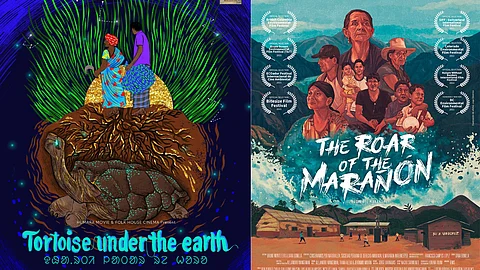
- HOMEGROWN WORLD
- #HGCREATORS
- #HGEXPLORE
- #HGVOICES
- #HGSHOP
- CAREERS
- ABOUT US
- CONTACT US

Is making a film simply about personal gratification or does it have a purpose to appeal to and reach the masses? When we create art for the masses, it is essential that we highlight issues that affects the many and not the few. In that light, what is a better topic that the world we live in—the planet that we all call our homeland. Climate change is one of the most pertinent issues affecting all of humanity. To raise awareness about it, and explores themes such as wildlife,conservation,indigenous culture, science, sustainability and more, environmental films play a key role.
One of the biggest mediums of mass communication, is films. Communicating ideas is best done through media because it is one of the key contributors of how our society functions and develops. Environmental communication,through films, is a way for filmmakers and environmentalists to convey the impact of humans on the world . Environmental films often portray the consequences of mistreating the world’s resources and ecosystems. It evokes emotion when the audience sees the negative impact they have created on the planet—the pollution, waste, poaching, enroachment of indigenous land and so much more damage in the name of development. Once an individual has an emotional connection to the cause, they are more willing to support it, thus creating positive environmental change.
When nature is captured on film, viewers are treated to an experience of being immersed in the natural world. By immersing viewers in the natural world, which they are polluting, the film becomes more relatable to reality as they can see the negative consequences they are imposing on the environment by their actions. ALT EFF, through its film festival All Living Things, seeks to replicate this experience and provide a platform for environmental films. The hybrid film festival, featuring the works of Indian and international directors, has already been underway from 17th November and will continue till 27th November 2022. Here are some of our top picks.
I. Murmurs of the Jungle (Aadigunjan) [2021]
This is a a Marathi short film written,directed and produced by Sohil Vaidya. Just like whispering trees passing on stories of gods and ancestors, various inhabitants of a small indigenous village in the Western Ghats speak of their stories. In the film, a gradual story unfolds that encompasses all of humanity and its symbiotic relationship to nature. Woods turns out to form a bridge between present and past.
II. Tortoise Under The Earth (2022)
This is a film in the Santhali language directed by Shishir Jha. It is a story of a tribal couple coping with the loss of their daughter in the uranium mining area in the state of Jharkhand, India. The story also highlights how deeply tribal groups are connected to each other,the forest and their culture This film has captured vivid colours of their festivals, togetherness and folk songs that bind them to their culture. While capturing different seasons in Jharkhand, the drastic change in environment is also noticeable.
III. Rat Trap (2022)
Rat Trap is a Hindi film directed by Rupesh Kumar Sahu with a wonderful soundtrack by Mães de Doane & the Carlos family. It is a film about the rat-hole coal miners who risk their lives to earn a livelihood. While doing this activity, many mishaps go unreported, which we cannot see from the outside. Their lives are devastating enough that they are called thieves in their own house, and during a case of mine collapse, they cannot even shed a tear or claim their loved ones’ body. This film narrates their daily life.
IV. Oil and Water (2020)
This is a Kenyan short film directed by Anjali Nayar.It depicts the lives of women of Northern Kenya as they navigate the opportunities and challenges of a massive oil discovery. As the promises fail to materialize, they must face the complicated web that stands in their way: greed, politics and the patriarchal fabric of their world.
V. The Mushroom Speaks (2021)
This is a Swiss film directed by Marion Neumann. It unfolds the healing qualities of fungi and their ability to regenerate. The film is a personal journey taking us on a walk alongside parasites, symbionts and decomposers, offering ideas of both interconnectedness and collaboration. Driven by a vision of resistance, the encounters seek possibilities of renewal and question what connects us when the world seems to be falling apart. With mushrooms and their allies, the film invites to imagine a myco-cultural (r)evolution. What if the fungus could help us address and radically change our relationship to this world?
VI. The Roar of the Marañon (2021)
This is a Peruvian film directed by Bruno Monteferri and Dana Bonilla.A chorus of voices calls out from the Marañon canyon, in protest against two planned mega-dams. What would the consequences be of interrupting this ancient, vital connection between the Andes and the Amazon? The dams would flood villages, unique forests and rock paintings yet to be studied. Communities and activist groups have come together to ensure that the Marañon river continues to flow freely.
You can watch all of these films and more here.
If you enjoyed reading this, we also suggest:
Attend A Hybrid Environmental Film Festival Exploring Climate Change & Indigenous Communities
India Action Project Is Working Towards Improving India’s Social, Political, & Economic Environment
The Gujarat School Creating A Learning Experience Shaped By Design & The Environment
